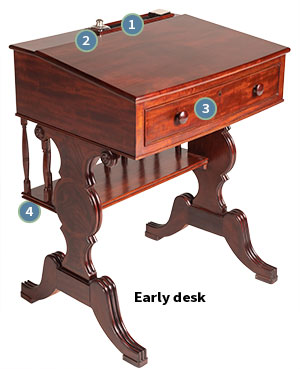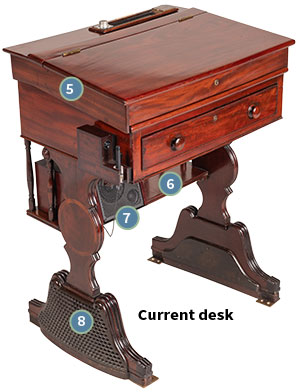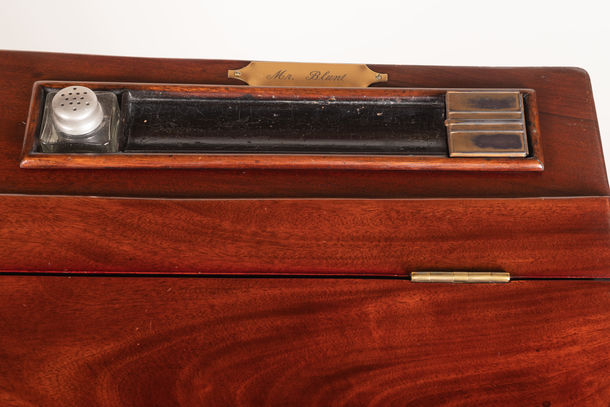

Every desk bears a nameplate with script lettering to identify the senator to whom the desk is assigned. While early nameplates were made of wood, and later silver and oroide, the nameplates are now brass.

Each of the 100 desks in the Senate Chamber holds a detachable wooden tray made for writing tools. The recessed trays are located in the upper-right corner of each desk (with one exception) and contain three distinct compartments. Constantine’s original desks each included a wooden tray, but evidence suggests trays on the earliest desks had been replaced by the late 19th century.
The trays’ design reflects the commonplace use of quills and other dip pens during the 19th century. The inkwell, located in the far-right section of the tray, consists of a copper-plated box with a hinged lid and a cobalt-blue glass liner for ink. The sander, located in the far-left section of the tray, is made of clear glass with a perforated twist-on metal top for shaking blotting sand (or pounce), which was gently sprinkled on freshly written documents to absorb and quickly dry the ink. Between the two compartments is a concave basin to accommodate pens and pencils.
By the early 20th century, the introduction of blotting paper and fountain pens made sanders and inkwells obsolete. However, in keeping with tradition, the Senate has retained its inkwells, sanders, and trays. The inkwells and sanders currently in use date to the 1930s.

The desk drawer provides a location to store books, papers, and other materials.

In 1820, mahogany bookshelves were added to the original 48 desks to provide additional space for books and papers. Since then, each desk has been constructed with a bookshelf.

During the 19th century, desks began to be fitted with mahogany writing boxes with hinged lids to provide more space for books and papers. The boxes increased the overall height of the desks and were likely added by request. Today only one desk—the Daniel Webster Desk—lacks a writing box.

At least seven distinct numbering systems, using both Roman and Arabic numerals, have been employed over the years to identify the desks, track their locations, and facilitate their arrangement in the Chamber. Many of these numbers are still visible on the desks. The first known numbering system was adopted in 1871, when the Senate paid Eugene O’Connor $4 to number all desks and chairs to correspond to a floor plan of the Senate Chamber. Additional numbering systems were introduced in 1872, 1875, 1890, ca. 1895, 1898, 1911, and 1912. The current numbering system, instituted in 1957, consists of Roman numerals stamped on the stretcher beneath each desk. The Senate Chamber desks are no longer arranged on the Senate floor in numerical order.

For many years, the Senate Chamber’s poor acoustics were a constant topic of concern. When the Chamber underwent extensive remodeling in the late 1940s, workers added conduits beneath the floor to permit the future installation of a "public address" and media broadcasting system. In 1969, the Senate authorized such a system, and in 1971 each Chamber desk was fitted with a small microphone on the left side and an amplification box on the bookshelf.
The microphones activate when removed from their holders, broadcasting a senator's words to low-volume speakers in the amplification boxes on the bookshelves and placed strategically throughout the public galleries. These boxes also amplify any words spoken from the clerks' and presiding officer's desks on the dais when microphones there are activated. Except for the substitution of digital for analog technology in 1994–1995, the original system remains in place today.

In 1896, the desk feet were enclosed with metal grilles that connected to an airway below the floor to improve air circulation in the Chamber. Although the 1896 ventilation system became obsolete with the introduction of air conditioning in the Senate Chamber in 1929, the grilles were never removed and remain on the desks today.

Did You Know?
On June 23, 1818, Speaker of the House Henry Clay received 13 bids on a project to completely refurnish the House Chamber, following the Capitol’s near destruction by invading British forces. Speaker Clay sought carpets, wall hangings, lamps, 187 chairs, and 51 tables. In ordering group tables, Clay continued the House practice of seating members together, presumably to symbolize their equality and interdependence. Aiming for utility and durability, rather than elegance and style, the frugal Clay selected the lowest bid. It came from a 27-year-old New York City cabinetmaker named Thomas Constantine.
The more deliberative Senate took much longer to arrange for its new postwar furnishings. With only six weeks remaining before the December 1819 convening of the 16th Congress, the Senate’s presiding officer, Vice President Daniel Tompkins, turned to the cabinetmaker the House had selected—Thomas Constantine. The vice president ordered 48 mahogany armchairs and desks as well as other furnishings for the Chamber. Constantine was paid $34 for each Senate desk, and $46 for each chair.
Constantine based his design of the Senate armchairs—today’s chairs are copies—on a sketch from an 1807 book on English furniture. His chairs reflected the influence of the then-popular French Empire and English Regency designs. Unlike the more commonplace House chairs, which he upholstered in black horsehair fabric, Constantine covered the Senate pieces in red morocco leather.
The easiest method of tracing desk occupancy prior to 1985 is to read the senators’ names written inside the desk drawers. These inscriptions appear to be a 20th-century tradition; the earliest recorded names date to the first decade of the 1900s. It is more difficult to verify the desks’ 19th-century assignees. For many years, Senate doorkeepers closely guarded such privileged information. Isaac Bassett, who worked in the Senate Chamber from 1831 to 1895, feared that souvenir hunters might damage the historic furniture if it were widely known which desks were used by such famous senators as Daniel Webster, Henry Clay, or John C. Calhoun.
Not all the names in the drawers were personally inscribed by senators. Many reveal an identical hand, suggesting either that older drawer bottoms were replaced and the names recopied, or that staff members, rather than senators, took responsibility for chronicling certain occupants.
Although the tradition of signing the desk drawers continues today, not all senators have chosen to do it. Since 1985, the Senate has tracked the occupant of each desk, whether or not they have signed the desk drawers.
The climactic scene of the classic 1939 film Mr. Smith Goes to Washington features Jefferson Smith, played by Jimmy Stewart, delivering an impassioned filibuster in the Senate Chamber. Because director Frank Capra was not permitted to film in the Chamber, he ordered the construction of a replica of the Chamber, complete with an entire set of reproduction Chamber desks fabricated by the Angelus Furniture Manufacturing Co. of Los Angeles. Director Otto Preminger brought Capra’s original set out of storage for use in his own 1962 film about the Senate, Advise and Consent, based on Allen Drury’s Pulitzer Prize–winning novel.
Although the Angelus Company duplicated many of the details of the historic Senate Chamber desks, a false writing top, rudimentary cast-iron ventilation grilles, and the absence of inkwells and pounce bottles are vital clues that these desks were created as movie props.
When British troops set fire to the Capitol in 1814, the Senate Chamber was extensively damaged and its furnishings destroyed. As part of the reconstruction effort, the Senate commissioned New York cabinetmaker Thomas Constantine to build 48 desks and chairs for its members. Completed in time for the reopening of the Chamber in 1819, Constantine’s chairs bore a close resemblance to a neoclassical design published by Thomas Hope in his Household Furniture and Interior Decoration (London, 1807).
As states were added to the Union, additional desks and chairs were produced by a variety of cabinetmakers to meet the demands of increased Senate membership. While all of the desks are still in use, sometime in the late 19th century the chairs were gradually removed. Only three of the original 1819 chairs have been located to date–two in private collections and one in the Senate Collection. A fourth chair, property of "Beauvoir," the historic post–Civil War home and library of Jefferson Davis in Biloxi, Mississippi, was destroyed in 2005 by Hurricane Katrina. Only a brass caster was found among the debris.
Today’s Senate Chamber chairs are made in the Senate Sergeant at Arms Cabinet Shop and are of a modified Thomas Constantine design. They are somewhat smaller and less intricately carved than those built in 1819. Senators are permitted to purchase their chairs upon leaving office, and replacement chairs are made after each election.